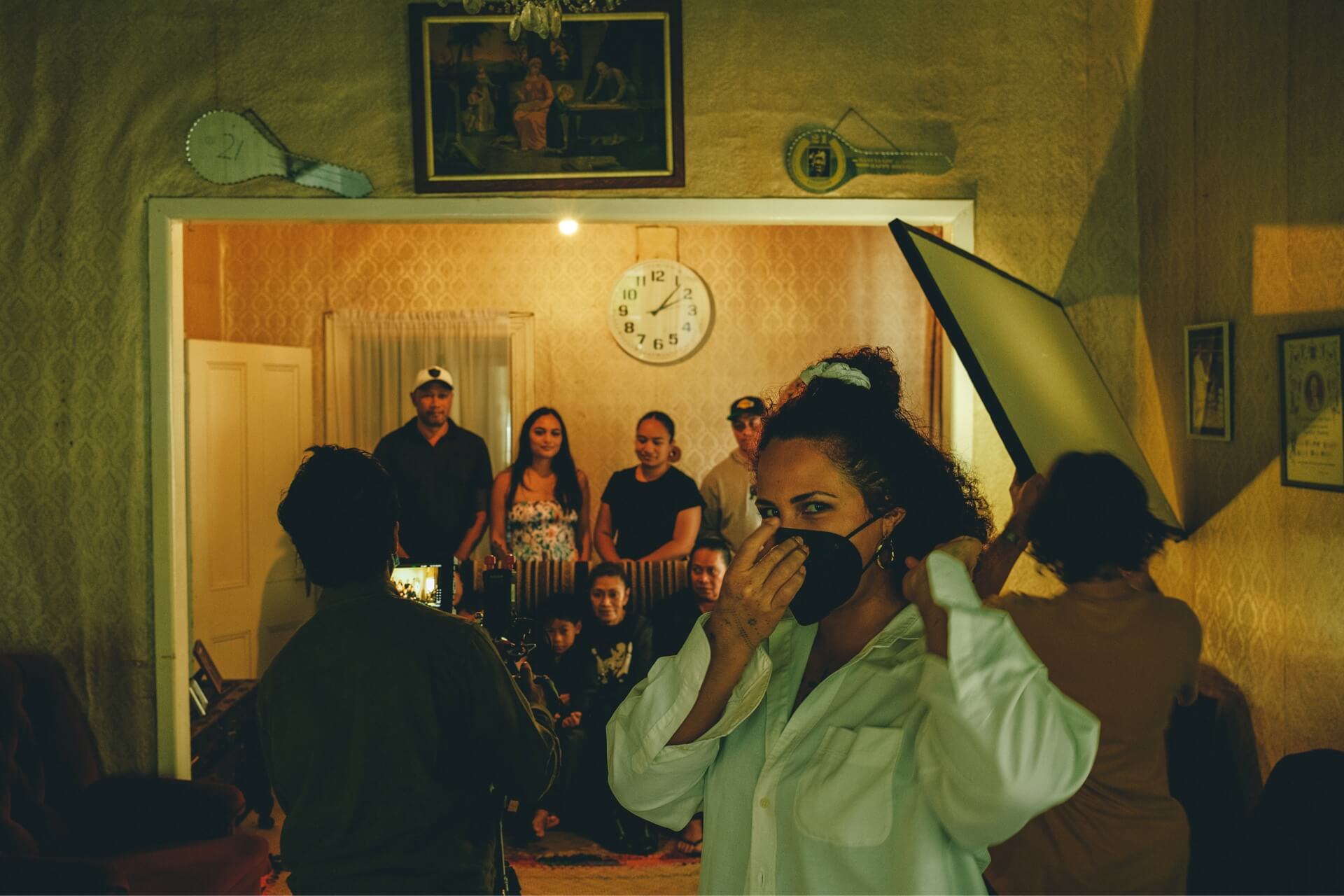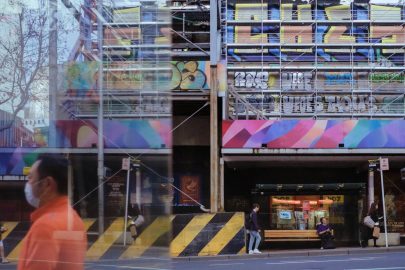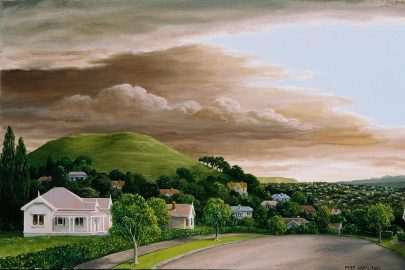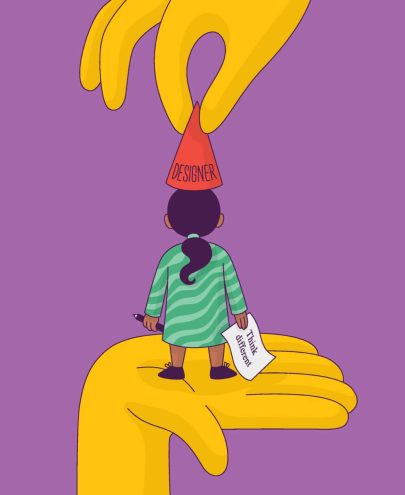Sep 12, 2022 Property
In 2017, Litia Tuiburelevu was shopping with her mum on Ponsonby Rd, when an older Niuean women came up to her. Speaking with familiarity, as if they knew each other, the woman started complaining about the real estate agents who’d recently been hassling her to sell her house, convinced it was only Pacific families who were being targeted.
Tuiburelevu was a University of Auckland law student at the time, and the exchange shaped Tuiburelevu’s next assignment: exploring the institutional racism within housing development policy. “Urban renewal has always meant brown removal,” Tuiburelevu says, as we sit on Karangahape Rd, heart of today’s liberal arts central city which, Tuiburelevu reminds me, has been made possible only by “removing little Polynesia”.
While researching her assignment, she started thinking about the families still living in the inner city — an idea that grew into the upcoming webseries Still Here, a six-part documentary profiling millennials from the Pasifika community remaining in Auckland’s affluent inner-city suburbs: Ponsonby, Grey Lynn and Herne Bay.
When Tuiburelevu told a family friend about the early idea for the show, they replied, “Well, that will be short because there’s no Islanders there anymore.” The response galvanised her to counter this myth, that the central Auckland Pacific community had evaporated. With gentrification of the central suburbs, and many workplaces shifting west and south, many Pacific people left the city — but not everyone. Armed with her idea and a strengthened resolve to tell these stories, Tuiburelevu posted on the Plantation Convos Instagram page on January 2020, asking to hear from any Pacific people still living in central Auckland who were interested in being included in a short documentary to “highlight why Pasifika peoples are so integral to central Auckland’s history”. The post received more than 100 comments in two days.
Before long, Tuiburelevu was shooting the leaving party for the Green Mansion, a green villa on Rose Rd that had just been sold by its owners the Williams family. The Niuean family had owned the house since the 1960s — it fetched just under $2 million at auction. In a media article on the sale, it was called a “virgin build” because its features were so untouched. The house has since been demolished, and the site is currently a pile of rubble.
Tuiburelevu herself grew up on Williamson Ave, but by the time she attended Ponsonby Primary in the 2000s she was one of only a handful of Pacific kids. Her family eventually left the inner city when she was 12. “I’ll always be a Grey Lynn girl,” Tuiburelevu tells me. “My placenta is buried at 44 Williamson Ave.” It is her dream to buy back the family home someday.
Because of the immense changes happening in the area, it’s “very easy to default to the historical record”. However, as Tuiburelevu reminds us, this story also exists in the present tense. While resistance (and succumbing) to gentrification is a story that runs through Pacific lives in the central city, for Tuiburelevu, the real story to be told is one of Pacific identities centred on family, joy and belong- ing. “When the cultural arteries are cut off or clogged up, it starts to put strain on the community and forces them to hold strong.” The result is a Pacific community which rides hard for the inner city.
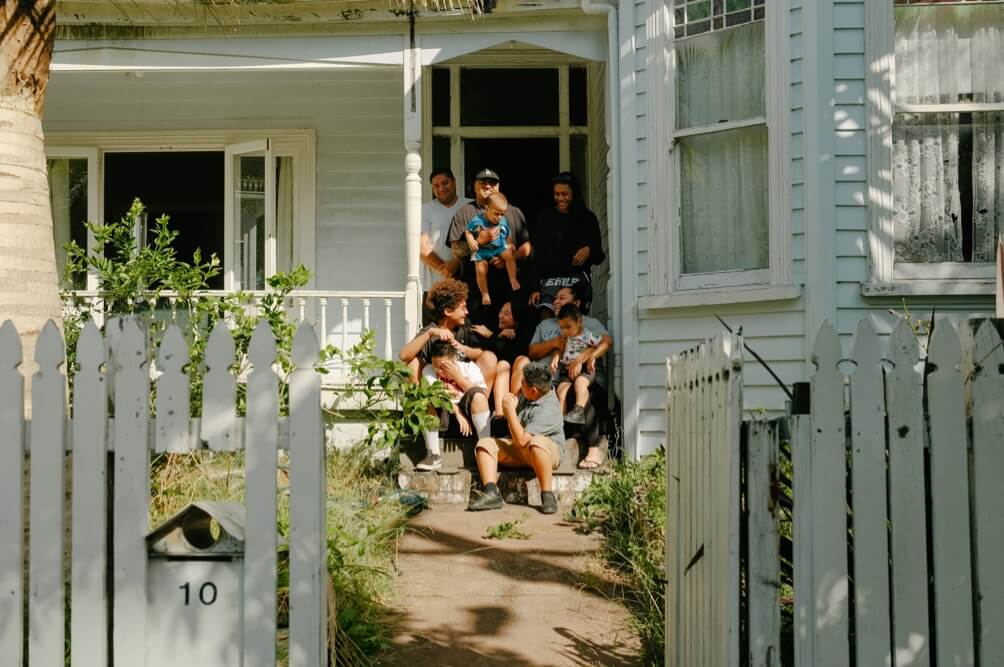
The Atiga family
When I visit Cynthia Ta‘ala Timaloa at her house on Elgin St, I spot the deep pink of some long-established tī plants and know I’m in the right place. Ta‘ala Timaloa’s mum, Makerita Fa‘amoe, came to New Zealand from Sāmoa on a scholarship — a skolasipi kid. In 1974, Fa‘amoe gave birth to Cynthia at 35 Dryden St — then Bethany House, the Salvation Army maternity unit for unwed mothers. Cynthia was named after the Bethany House nurse who birthed her. She grew up at 298 Great North Rd, on Surrey Cres, and went to Grey Lynn Primary where she was smacked with the cane for speaking Samoan. Unknown to her at the time, Ta‘ala Timaloa’s dad Ta‘ala Fasitalo Fa‘amoe commuted to the Fisher & Paykel factory in East Tāmaki by bus every day. The long trek led to the family eventually packing up and buying a house in Ōtara.
I’m talking to Ta‘ala Timaloa in her husband Will Timaloa’s family house, known affectionately by those in the area as ‘Elgin’. The house was originally owned by Reverend Vaomu Lima and Paea Lima who answered a calling to serve the Presbyterian Pacific Island Church in the South Island. In 1968, Paea Lima’s brother So‘oalo Mafola Loli Timaloa and his wife Taufanuu Taino Timaloa, known as Nana T (Cynthia’s parents-in-law), decided to buy the Elgin St house.
As I walk down the hallway, the house feels much longer than most villas, which is because the Timaloas extended it in 1974, before the heritage restrictions came in. It’s the longest villa on the block by a few good metres. Like the Green Mansion, Elgin is clearly a hub. As well as being home to the six Timaloa kids, the house had an open-door policy for the wider community, and even hosted a couple of weddings.
Today, Ta‘ala Timaloa and her husband live in the house with their two sons, who are 15 and 27. Their dream is “to keep the home in the family”. They hold on to that dream, while getting real estate agents regularly knocking on their door. They also get mistaken for renters. “We just laugh at it now, instead of getting really mad.”
How, I ask, do they keep their culture alive today in a place like Grey Lynn, where most of their community has sold up and moved on? Looking around, the answer becomes obvious. The house is lined with assorted Richmond Rovers memorabilia.
For many Pacific families still in the city, sports clubs are important community and cultural hubs. Teams like the Rovers — the Ponsonby Rugby Club and the now-defunct City Newton Dragons rugby league club, which has since been absorbed into the Ponsonby Ponies — are crucial. This is especially true for the Timaloa family.
Ta‘ala Timaloa has an impressive playing career herself. At 16 she represented New Zealand in basketball, and then first played league for the Kiwi Ferns in 1999. In 2014, she captained Manusina Samoa, the Samoan women’s rugby team, for which she is now the assistant coach. Ta‘ala Timaloa also played for the Richmond Roses, the sister team to the Rovers, set up by Afi Ah Kuoi.
The Richmond Rovers Rugby League clubrooms are a stone’s throw from the Timaloa family house, on the other end of Elgin St. Sitting right on Grey Lynn Park, the clubrooms are pretty stock-standard, but always tidy. While the club started in 1913 by working-class Pākehā, it quickly grew to be Pacific dominated in the 70s and 80s, firstly by the Tokelauan community in the area. With Grey Lynn Park as its home ground, it was within eyeshot of many Pacific parents, who could see their kids playing from their houses.
Get anyone on the topic of Richmond Rovers and names such as ‘Ah Kuoi’ and ‘Solomona’ get mentioned — families who are also still in Grey Lynn, with long histories at the club. The demographic shifts of the area created some turbulence for the club; however, what kept it going was not just the Pacific community still in the inner city but the commitment to the club from those willing to drive in and to keep the familial Richmond legacy alive.
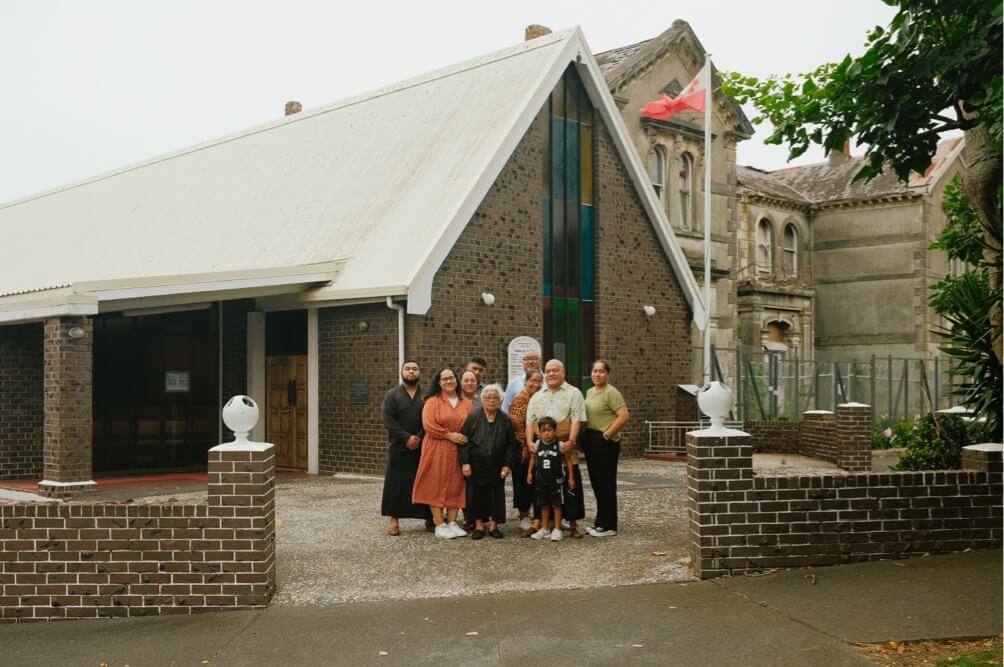
The Kolomatangi family
Budding art historian and doctoral student Fine Lavoni Koloamatangi lives on Dryden St, in a house her paternal grandpa Saimone Koloamatangi bought in the late 1970s and lived in with his wife, Grandma Kato‘one, and their children. Grandpa Saimone worked at the post office in the central city, and Grandma Kato‘one in a rest home just up the road. The Koloamatangi kids attended the local schools, St Paul’s College and Auckland Girls’ Grammar School.
The house on Dryden St wasn’t just a family home, though — it was also a stepping stone for the Koloamatangi kāinga or wider family and other Tongan families while they found their feet after arriving in Tāmaki Makaurau. While Koloamatangi lived in Onehunga for a brief period growing up, as her parents relocated for study, their socio-cultural lives always revolved around Grey Lynn, mostly because of the United Church of Tonga.
Koloamatangi’s paternal grandparents, as well as her maternal grandparents Suaesi and Penina Hu‘akau, along with other Tongan families in the area, set up the United Church of Tonga in 1977 at 90 Richmond Road, a brown-and-black-brick building deceptively bigger on the inside than it looks from the street. Another important cultural touchstone was the Fōfō‘anga kava club, which Grandpa Saimone set up in 1978 in a clubhouse out the back of the Dryden St house.
The United Church of Tonga was intended to create a safe space for Tongans to worship without fear; Koloamatangi suspects the elders who set it up also wanted to retain and nourish a core part of their Tongan identity and to cater to a growing Tongan population in the city.
Grandpa Suaesi became an ordained minister of the church and Grandpa Saimone, who held the matāpule title Mafua ‘ae Lulutai, advised on Tongan cultural matters, performing certain duties when needed.
The United Church of Tonga is entwined with Koloamatangi’s family story — it’s where her parents met, where she and her siblings grew up and it’s a place that still plays a big part in their contemporary lives. For Koloamatangi, “the church is important in maintaining a Tongan and Pacific presence here in Grey Lynn — not in the least as one of the enduring symbols of the Pacific story in the inner city”.
Pacific churches are important “cultural arteries” — to use Tuiburelevu’s term — that both hold Pacific families in the city, and give families who have since left reasons to come back in, not unlike the Richmond Rovers. And the more people you talk to, the more connections you find between the two.
For such a small geographic area, there is an abundance of Pacific churches. Newtown PIC is of course the best-known, but there is also the Tongan Methodist Ponsonby Church, also on Richmond Rd, and the Ekalesia Fa‘apotopotoga Kerisiano Samoa Grey Lynn (EFKS for short) on Sussex St. Cynthia Ta‘ala Timaloa’s father-in- law, So‘oalo Mafola Loli Timaloa, was one of the founding members of that EFKS in 1962, when it was called EFKS Aukilani.
One church has recently succumbed to the changing tides of the area. Since the 1960s, the Auckland Samoan Parish of the Methodist Church of New Zealand had occupied the old St John’s Church on Ponsonby Rd, built in 1882. At the time, this very first Methodist Samoan parish was created to meet the social and cultural needs of its Samoan members. However, with most of the congregation now in South Auckland, the parish made the decision in 2020 to sell.
Like many of the churches in the area with their decades of history, the United Church of Tonga has had a storied existence on Richmond Rd. It is now 45 years old. “It seems miniscule in the grand scheme of things,” Koloamatangi says, but she wants this important story to be reclaimed — “for fear of it being lost”.
Koloamatangi tells me that there’s a sense that the area’s current affluence will obscure the Pacific chapter of its history while ironically also providing the necessary conditions for it to be told. “It’s a challenge worth overcoming,” she says, “and a story worth telling.” When Koloamatangi thinks about her grandparents, she remembers the “complexities, nuances, and grey areas of this new place” which they endured “to bring their vision of a better future for us to fruition”.
With a hint of optimism, Koloamatangi doesn’t really think that “Pacific families ever really left Grey Lynn”. This is partly because of the influx of families for church on Sundays, but she also cites the weekly rugby and rugby league trainings at Grey Lynn Park. “Earlier this year, when we dropped my nephew off at Richmond Road School for his first day, we were greeted by old family friends who were dropping off their kids to school as well. It felt like there was a sense of possibility in the air, as if the Pacific soul of the neighbourhood was slowly returning.”
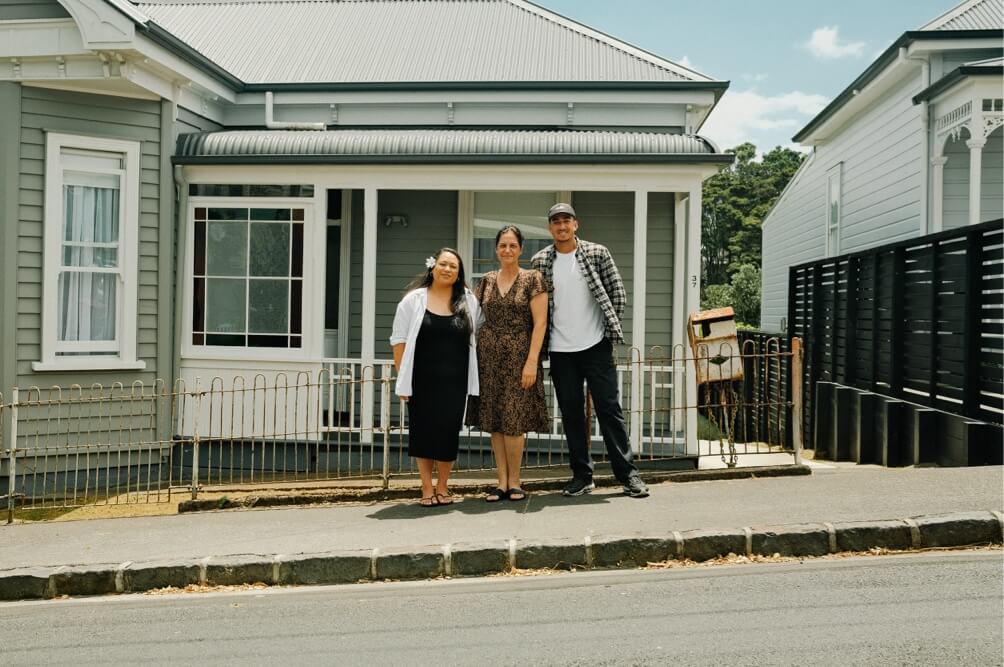
The Toleafoa family
I was there on the morning that Koloamatangi dropped her nephew off at Richmond Road Primary School, home to A‘oga Fa‘a Samoa and Mua i Malae, the longstanding Samoan-language early childhood centre and bilingual primary school unit respectively. For eight years now I have commuted to Grey Lynn from West Auckland to drop off and pick up my own children there. The commute to many seems extreme (and we started it when our kids were only months old) but we felt it was worth it for the cultural backbone the centre and school provided.
Find yourself on Brown St or Douglas St at the right time of day and you might hear morning lotu or prayers, ‘Happy Birthday’ sung in four languages (Samoan, te reo Māori, French and English), or see the kids playing the dodgeball-esque togi togi ga i‘a.
A community of parents together with Richmond Road Primary School established Mua i Malae in the 1980s. It was a way to support many of the kids who spoke Samoan as a first language and struggled in mainstream primary school. Today, however, the tables have turned: for many families this is a pathway to cultural enrichment.
Feeding directly into the unit is A‘oga Fa‘a Samoa, the first Pacific-language early childhood centre in New Zealand, established in 1984. Originally located in Herne Bay at the Pacific Island Resource Centre, the centre moved on to the Richmond Road school grounds in 1987.
This is where, a few years ago, I first met Susana Guttenbeil (née Talagi). While many of the families at A‘oga Fa‘a Samoa and Mua i Malae travel in from other parts of Auckland, some, like Guttenbeil, come from just down the road. I arrive at Guttenbeil’s family house on Harcourt St in the middle of the day, interrupting a Zoom meeting that the very busy general manager of content at the Pacific Media Network (and mum to triplets) is in. Sitting on the couch, I can hear someone listening to a Pacific-language radio programme down the hall; it’s Guttenbeil’s mum.
Guttenbeil’s dad is the late Rev. Lagaua Talagi, who was born in 1929 and migrated from Niue to Wellington in 1956. There he found himself doing a range of roles including interpretation work for non-English speakers, which led to being approached by Rev. Bob Challis to train in the ministry. With what seemed like a natural tenacity to lead, and a mission to help people, he left for Auckland in 1967 to start his training, eventually leading the Niue section of the Newton PIC church. In 1968, Rev. Talagi bought the Harcourt St house, and over the past 50 years vast numbers of friends, church and family members have been welcomed through its front door.
It’s clear that service to Pacific communities is at the heart of the Talagi–Guttenbeil family, and language retention and immersion is a family priority. However, practical considerations also come into play. Guttenbeil is real about these, saying that while she has strong family links to the inner city through church, the Samoan language school and her family home, there are other pressing factors that may eventually see the family leave. Both Guttenbeil and her husband work in South Auckland, which makes school pick-up and drop-off nearly impossible.
Beyond that, it’s not a functioning community anymore, Guttenbeil tells me. “This is not the neighbourhood I grew up in.” For now, though, Guttenbeil’s children remain at Mua i Malae, and the a‘oga amata or preschool run by the EFKS church on Sussex St. But if the family does leave, she’s taking the front door with her.
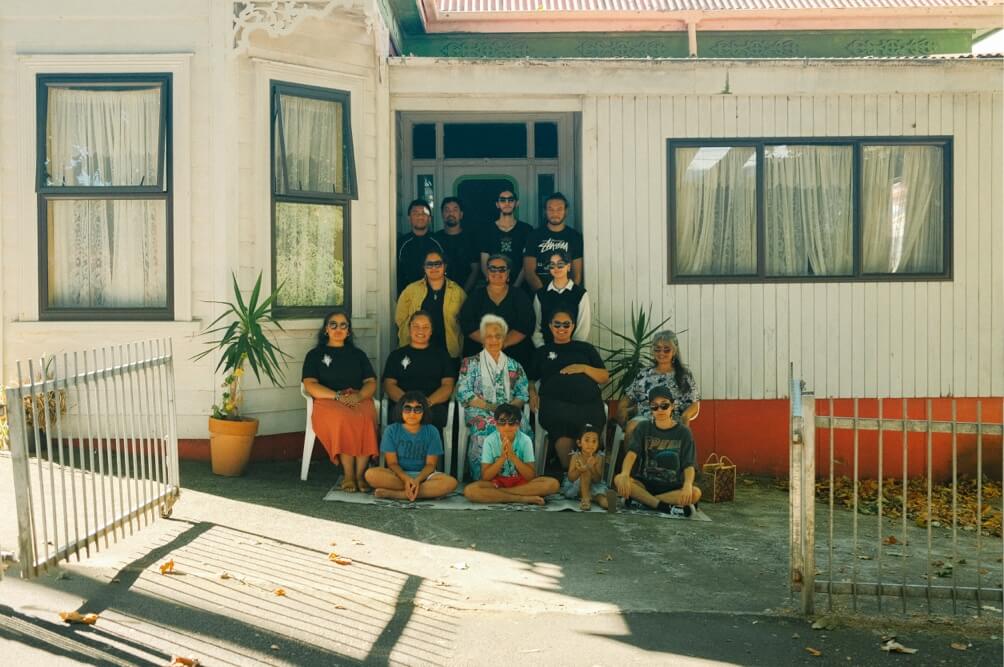
The Tele family
“My parents were part of the early migration of young Samoans and other Pacific people who travelled to Auckland in the 1950s replete with hopes and dreams of a new life,” Faleafa Toleafoa, former inner-city police officer and Richmond Road Primary School alumnus tells me.
In 1958, Faleafa’s parents Lealofi Toleafoa and Peseta Saunoa Toleafoa bought their house on O’Neill St. The house was a far cry from the villas we see there now. “It was a dilapidated property that was in a state of disrepair that had not been treated to a lick of paint or new wallpaper for many years. The poor condition of the house was not exceptional for the neighbourhood at that time, as Ponsonby was a well-worn and tired suburb.”
Growing up with his four siblings, Faleafa enjoyed the “village atmosphere” of Ponsonby, full of diverse new migrants of all kinds. While that particular version of Ponsonby has gone, he’s adamant that he still enjoys life in the inner city — beyond anything thing else, it’s home.
Twenty-six years ago, Faleafa took over the family house, where he still lives today with his wife, son Stuart, daughter Lahaina and her partner Tai. Lahaina, a University of Auckland law student and Ura Tabu dancer, is also aware of the constant change in the area. “As each year passes and another Pacific family leaves the area, the social fabric of our inner city continues to change,” she says. “When I walk around the neighbourhood today, I get excited seeing another brown face in the crowd. It’s like a feeling of relief knowing pieces of the old Ponsonby are still here.”
Like many houses owned by Pacific families, the O’Neill St house is headquarters for the wider Toleafoa family. When Lahaina comments, “I feel profoundly attached to it and will treasure it forever”, I’m reminded of Tuiburelevu’s declaration that she’ll always be a Ponsonby girl.
Faleafa himself is a Richmond Rovers and Ponsonby Rugby Club old boy (and still a member today at that). The schools and sports clubs, Faleafa tells me, “connect us closer to each other and give us a sense of belonging and some identity in the community”.
The more inner-city folks I speak to, the more I see that beneath the schools, the rugby clubs, the churches (and organisations of another kind like the King Cobras), it’s really all about the people. When you delve into the histories of these organisations, webs of families and their past and present connections to the inner city rise to the surface. While stories of the Polynesian Panthers and the Dawn Raids have rightfully dominated the local narrative for the past couple of years, there are quieter stories of Pacific domestic life that also deserve time in the sun.
That community, past and present, has been vital for the Toleafoa family. “The neighbours we have known over the years and the many faces of Ponsonby’s development have kept us grounded and forever grateful for being part of the inner city’s story,” Faleafa says. While it’s clear how important Ponsonby is for the Toleafoa family, there’s also nonchalance. “Ponsonby just happens to be the place where we settled,” Faleafa continues. “It’s an amusing relief that we no longer have to feign a cough as we mumble ‘Ponsonby’ when someone asks where you live.”
I ask Tuiburelevu what she most hopes audiences will take away from Still Here. A month later I get an answer over email: “I know we exist in time where shows must compete for a fraction of our limited attention spans. I get it, but this series isn’t about quick hits. It’s a love letter to a community.” She continues, “There’s so much to be found in the stillness.”

